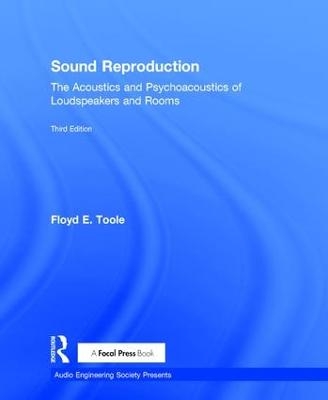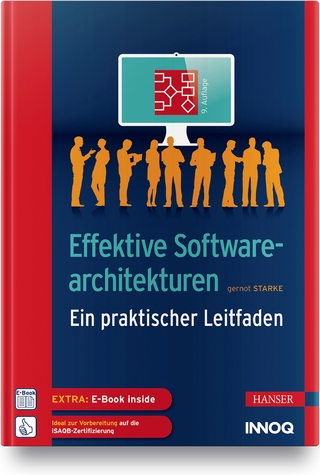
Sound Reproduction
Routledge (Verlag)
978-1-138-92137-5 (ISBN)
Understanding the principles of sound production is necessary to achieve the goals of sound reproduction in spaces ranging from recording control rooms and home listening rooms to large cinemas. This revision brings new science-based perspectives on the performance of loudspeakers, room acoustics, measurements and equalization, all of which need to be appropriately used to ensure the accurate delivery of music and movie sound tracks from creators to listeners.
The robust website (www.routledge.com/cw/toole) is the perfect companion to this necessary resource.
Floyd E. Toole is a consultant for Harman and a Fellow of the AES, the Acoustical Society of America and CEDIA, and is in the Consumer Technology Hall of Fame.
Acknowledgements
Introduction
Chapter 1: Sound Production vs. Sound Reproduction
Live Classical Musical Performances
Live Popular Music Performances
Reproduced Sound – The Audio Industry
Preserving the Art – The Circle of Confusion
Music and Movies – the State of Affairs
The Role of Loudspeakers and Rooms
Human Adaptation, a Reality the Cannot be Ignored
Human Suggestibility
Chapter 2: A Scientific Perspective on Audio
Requirements for Scientific Investigations
Chapter 3: Subjective Measurements – Turning Opinion into Fact
Is Blind Listening Necessary?
Hearing Ability and Listener Performance
Stress and Strain
How Many Channels?
Controlling the Variables in Subjective Evaluations
Controlling the Physical Variables
The Listening Room – Making Tests Blind
Real-time Loudspeaker Comparison Methods
Binaural Record/Replay Loudspeaker Comparisons
Listener Position and Seating
Relative Loudness
Absolute Loudness – Playback Sound Levels
Choosing Program Material
Power Amplifiers, Wire and So Forth
Controlling the Psychological Variables
How to do the Test
Is it preference or accuracy that is evaluated?
Chapter 4: The Perceptual and Physical Dimensions of Sound
The Frequency Domain
The Amplitude Domain
Amplitude and Frequency Together: Frequency Response
Amplitude and Frequency Together: Equal-Loudness Contours
Loudness Controls and Tone Controls – Do They Work, Are They necessary?
The Boundaries of What We Can Hear
What Is Acceptable Background Noise?
Linear Distortions: Amplitute and Phase vs. Frequency
Spectral Tilt
Resonances Viewed in Frequency and Time
Finding and Fixing Resonances
A Persistent Problem: Differentiating Between Evidence of Resonances and Acoustical Interference
Critical bands, ERBNs, and the "resolution" of the hearing system
Amplitude, Frequency and Time Together: Waterfall Diagrams
Phase and Polarity – Do We Hear Waveforms?
The Audibility of Phase Shift and Group Delay
Phase Shift at Low Frequencies: a Special Case
The Audibility of Absolute Polarity
Non-Linear Distortions
Wavelength, the Key to Understanding Much in Audio
Loudspeaker Directivity
Room Resonance Basics
Resistive/Porous Absorbers and Membrane/Diaphragmatic Absorbers
Diffusers and Other Sound Scattering Devices
Chapter 5: Characterizing Loudspeakers – Can We Describe What is Good?
The Wisdom of the Ancients
Identifying the Important Variables – What do we Measure?
Anechoic Measurements – the Spinorama Evolves
Total Sound Power as a Measured Parameter
Why do we measure what we do? Are there better ways?
Predicting Room curves From Anechoic Data – An Exercise in curve Matching.
A Message About Sound Absorption and Scattering
Why Do We Care About Room Curves?
Closing the Loop − Predicting Listener Preferences From Measurements
The Olive Experiments – Part One
The Olive Experiments – Part Two
The Olive Experiments – Part Three
Loudspeaker Resonances – Detection and Remedies
Summary and Discussion
Chapter 6: Loudspeaker/Room Systems – an Introduction
One Room, Two Sound Fields – The Transition Frequency
A Brief History of Loudspeaker/Room Interactions
Timbral and Spatial Effects Attributable to Rooms
Chapter 7: Above the Transition Frequency: Acoustical Events and Perceptions
The Physical Variables: Early Reflections
Problems with the Stereo Phantom Center Image
The Physical Variables: Loudspeaker Directivity
The Physical Variables: Acoustical Surface Treatments
Absorbers
Engineered Surfaces and Other Sound Scattering/Diffusing Devices
Subjective Evaluations of Physical Variations
Side Wall Treatment: Reflecting or Absorbing –Kishinaga et al. (1979)
The Effect of Loudspeaker Directivity – Toole (1985)
Loudspeaker Directivity and Wall Treatment Together – Choisel (2005)
The Nature of the Sound Field – Klippel (1990)
Observations of an Audio Enthusiast – Linkwitz (2007)
Observations of an Audio Enthusiast – Toole (2016)
Floor Reflections: A Special Case?
Professional vs. Recreational Listening
Hearing Loss is a Major Concern
Discussion
Perceptual Effects of Room Reflections
Adaptation and Perceptual Streaming
The Effect of Rooms on Loudspeaker Sound Quality
The Effect of Rooms on Speech Intelligibility
Sound Localization in Reflective Spaces − The Precedence (Haas) Effect
Bringing the Precedence Effect into the Real Acoustical World
Ceiling vs. Wall Reflections
Real vs. Phantom Images
Speech vs. Various Musical Sounds
Meaningful Measurements of Reflection Amplitudes
Chapter 8: Below the Transition Frequency: Acoustical Events and Perceptions
The Basics of Room Resonances and Standing Waves
Optimizing Room Dimensions – Does an "Ideal" Room Exist?
Are Non-Rectangular Rooms the Answer?
Solutions for the Real World
Deliver Energy to the Modes and Dissipate Some of That Energy with Absorbers
Deliver Energy to the Modes and Reduce the Coupling of That Energy to the Listener By Optimizing the Listening Location – "Positional" Equalization
Reduce the Energy Delivered to a Bothersome Mode by Optimizing the Loudspeaker/Subwoofer Location
Reduce the Energy Delivered to a Bothersome Mode by Using Parametric Equalization
Reduce the Energy Delivered to a Bothersome Mode by Using Simple Mode-Manipulation Techniques
Selective Mode Activation in Rectangular Rooms Using Passive Multiple-Subwoofer Mode Manipulation
Mode Manipulation for Rectangular Rooms Using Multiple Subwoofers and Signal Processing
Mode Manipulation For Any Room Using Multiple Subwoofers and Signal Processing: Sound Field Management (SFM).
Revisiting Room Resonances in Time and Space
Do we Hear the Spectral Bump, the Temporal Ringing, or Both?
Stereo Bass: Little Ado About Even Less
Bass Management Makes it all Possible.
Summary and discussion
Chapter 9: Adjacent boundary and loudspeaker mounting effects
The effects of solid angles on the radiation of sound by omnidirectional sources
Classic adjacent-boundary effects
Alleviating adjacent-boundary effects
Loudspeaker mounting options and effects
An example of adjacent-boundary interference
"Boundary-friendly" loudspeaker designs
Array loudspeakers – other ways to manipulate boundary interactions
Listeners also have boundaries
Chapter 10: The Sound Fields in Sound Reproduction Spaces
Reverberation
Measuring reverberation time
Calculating reverberation time
Is there a more useful metric for our purposes?
Diffusion
Direct sound and early reflections
Near and far fields of rooms − sound level vs. distance
Near and far fields of sound sources
Point sources and real loudspeakers
Line sources
Air absorption at high frequencies
Screen loss in home theaters and cinemas
The directivities of common sound sources
Chapter 11: Sound in cinemas
The closed loop of cinema sound
Sound fields in cinemas
A loudspeaker in a cinema
Adding a screen and applying the X-curve
The origins of the X-curve
A recent study adds confirmation and clarity
Flat, direct sound is an enduring favorite
Alternative targets – is it time to move on?
Compatibility with the rest of the audio world
Compatability with the cinema world
The effects of room size and seats
Cinema sound – where to next
Chapter 12: Sound in home listening rooms, home theaters and recording control rooms
Good sound starts with good loudspeakers
Typical loudspeaker specifications – part of the problem
Loudspeakers in small rooms: the meaning of room curves
The effect of loudspeaker directional configuration
Looking back 42 years: the Møller/Brüel and Kjaer experiments
Room curves and equalization
Subjective preferences for sound spectra in listening rooms
Dialog intelligibility in home theaters
Recording control rooms
Old-school monitoring
Modern monitoring
Chapter 13: A rational approach to designing, measuring and calibrating sound reproducing systems
Low frequencies – the universal problem
Sound above the transition frequency
Thirty years – some things change, some don’t
The wrong room curve target?
"Room correction" and "room equalization" are misnomers.
Automotive audio
Headphones
Cinemas
Is there a common factor – a generalizable target?
Chapter 14: Measurement methods
Alternative views of frequency response
Prediction of the direct sound and room curves from anechoic data
In-situ measurement of the direct sound
The steady-state room curve
Measures of loudness and system level calibrations.
Evaluating relative program loudness levels
Multichannel system level calibration
The effect of propagation distance – a side-channel challenge
Measurement microphones
Chapter 15: Multichannel Audio
A few definitions
The birth of multichannel audio
Stereo – an important beginning
Loudspeakers as stereo image stabilizers
Quadraphonics – stereo times two
Multichannel audio – cinema to the rescue
Multichannel comes home
THX embellishments
How many loudspeakers and where?
Optimizing the delivery of "envelopment"
Summary
Surround system layouts
Loudspeaker directivity requirements
Mission oriented acoustical treatments
Surround loudspeaker options
The Ambisonics alternative
Upmixer manipulations: creative instincts at work
Multichannel audio goes digital, discrete and compressed
Three-dimensional sound – immersive audio
The perception of elevation
Chapter 16: Loudspeakers and Power Amplifiers
Consequence of Loudspeaker Impedance Variations
The Damping Factor Deception
Loudspeaker Sensitivity Ratings and Power Amplifiers
The Audibility of Clipping
Chapter 17: Hearing loss and hearing conservation
Occupational noise exposure limits
Non-occupational noise exposure
Binaural hearing is also affected
Some obsession can be a good thing
Chapter 18: Fifty years of progress in loudspeaker design
My introduction to the real world
Two decades of domestic loudspeakers
Some early professional monitor loudspeakers
A "Toole" monitor loudspeaker
Looking around and looking ahead
The end
References
Index
| Erscheinungsdatum | 30.01.2018 |
|---|---|
| Reihe/Serie | Audio Engineering Society Presents |
| Zusatzinfo | 1 Tables, black and white; 175 Line drawings, black and white; 52 Halftones, black and white |
| Verlagsort | London |
| Sprache | englisch |
| Maße | 191 x 235 mm |
| Gewicht | 1224 g |
| Themenwelt | Kunst / Musik / Theater |
| Mathematik / Informatik ► Informatik | |
| Technik ► Nachrichtentechnik | |
| ISBN-10 | 1-138-92137-8 / 1138921378 |
| ISBN-13 | 978-1-138-92137-5 / 9781138921375 |
| Zustand | Neuware |
| Haben Sie eine Frage zum Produkt? |
aus dem Bereich


